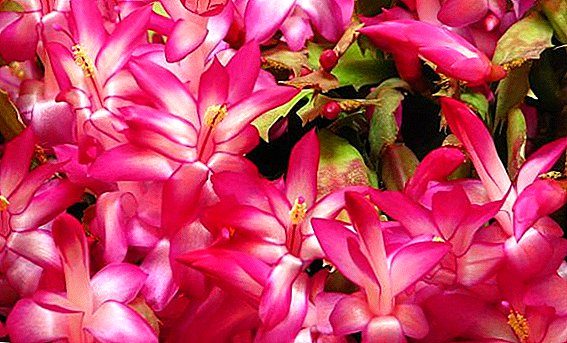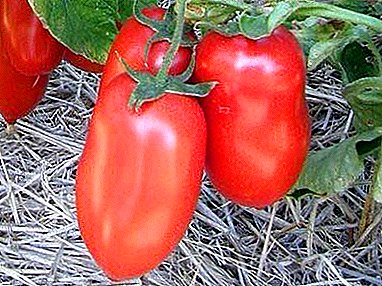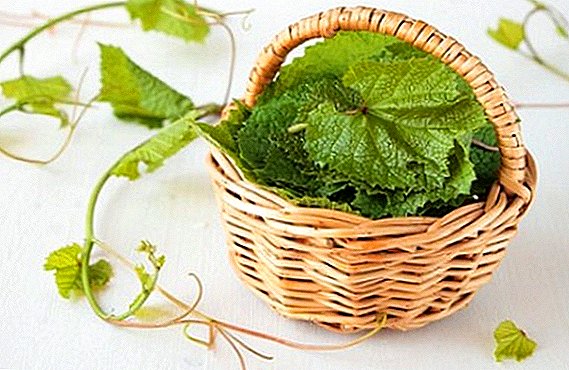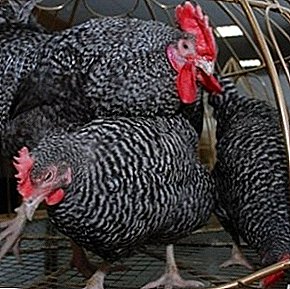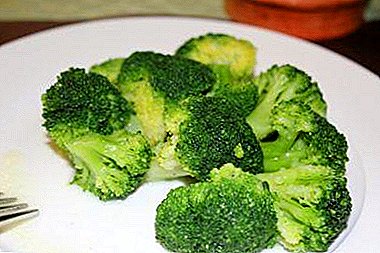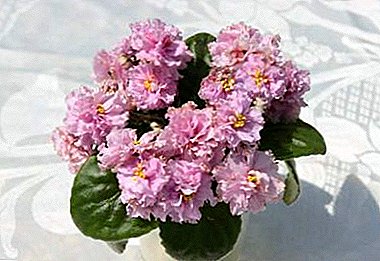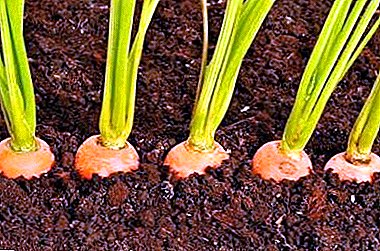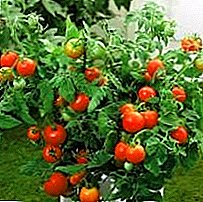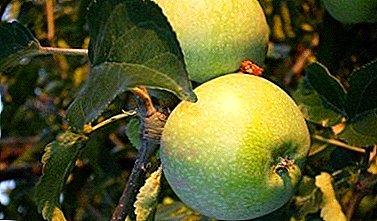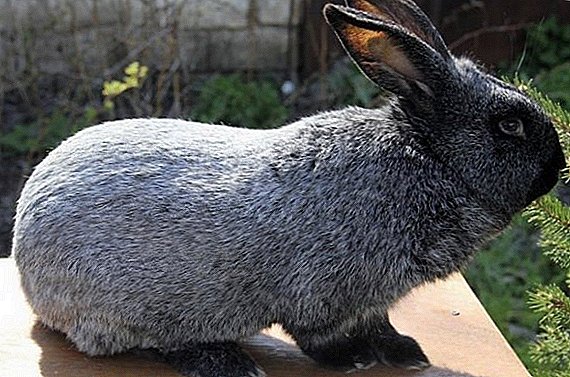 In the rabbits of the Poltava silver breed, good quality fur and skins are combined, which makes them a valuable object of small animal husbandry.
In the rabbits of the Poltava silver breed, good quality fur and skins are combined, which makes them a valuable object of small animal husbandry.
This beautiful animal deserves its high place in the rabbit breed hierarchy.
Breed description
This breed can not be confused with any other, since the coat of silver-smoky color is typical for this representative of the species. Although, due to the numerous alternative names, confusion may arise with the definition of species. "Poltavan" is also called the Soviet silver, silver, silver.
Did you know? The fur of the rabbit of the Poltava silver breed is called a rollback, in this case it can be translated from English by the term from equestrian sport - “turn by 180 °”. Here we have in mind the feature of the hairs to have a light shade of gray at the base and darken significantly to the end.
Inference history
The animals with silver fur were found in the Middle Ages in India, and brought to Europe by Spanish navigators, where the French liked the most, who through a long selection bred the Champagne breed. Soviet scientists began working with this species at once in two nurseries - "Petrovsky" (Poltava region, Ukrainian SSR) and "Fur" (Tula region, RSFSR). It was the Poltava people in 1952 who were able to create a breed with beautiful fur, tasty meat and resistant to cold weather conditions. 
Appearance and physique
Representatives of Poltava silver have developed muscles. These animals are quite large in size, which distinguishes them from similar breeds bred by other breeders.
Get acquainted with the best representatives of meat, down and fur, as well as decorative breeds of rabbits.Here are the main external characteristics of Silver:
- Body longer than that of fellow European breeders, muscular, harmonious.
- Color in newborns, black baby rabbits, and by the 4th month begins to acquire its "corporate" silver color. When growing up, the color of the fur appears more and more light-gray villi, giving the animal a "noble gray hair".
- Head has an oblong shape, which, again, does not agree with the shorter skull of European analogues.
- Ears proportional to the body and well worth it.
- Eyes brown.
- Neck muscular, normally developed.
- Chest The middle structure, and the rear part of the trunk arched, rounded;
- Back straight, flat throughout.

Productive characteristics
The attractive appearance of the animal is complemented by rapid puberty, high performance and excellent meat taste. All this together makes the breed very valuable.
Productive characteristics are as follows:
- the weight of an adult rabbit is about 6 kg;
- body length is about 55 cm, sometimes up to 60 cm;
- The recommended slaughter age is 3-4 months, when an individual reaches a mass of 1.5-2 kg, since further feeding becomes economically unprofitable, and besides at that age, the meat has a very delicate taste;
- meat output in 3-4 months of age ranges from 55 to 65% of body weight;
- Approx in selected manufacturers occurs approximately one month after conception (from 28 to 33 days) - the bunny brings in a litter of 8-9, and sometimes 12 babies.

Advantages and disadvantages
Speaking of Poltava silver, it is worth highlighting only the advantages of this breed compared to other rabbits. No joke, that his skin is almost the same level of quality and color with chinchilla, while it has a large area. Such indicators are very much appreciated by manufacturers of fur coats.
Read about other representatives of the breeds of rabbit meat and skin directions: Rex and Viennese blue.
There are practically no drawbacks to this “Poltava citizen”, but there are a lot of advantages:
- balanced psyche and lack of aggression;
- early puberty;
- high fecundity;
- rather large size;
- frost resistance and the possibility of keeping in unheated premises;
- unpretentiousness in the diet;
- tasty, juicy meat of noble marble color;
- getting used to the day routine and attendants;
- thick, beautiful and high-quality fur.
 Among the shortcomings, one can single out the fact that animals are difficult to tolerate heat and high humidity.
Among the shortcomings, one can single out the fact that animals are difficult to tolerate heat and high humidity.Maintenance and care
Individuals of the Poltava silver breed are completely unpretentious to the conditions of detention and acclimatized under the harsh winter. Moreover, the cold winter gives their skin a special beauty.
Important! The calm temper of this breed makes it possible to keep him as a pet in the conditions of an apartment. However, the genetic focus on reproduction will make in this case a happier host than an animal devoid of the use of instinct laid down by nature.
Selection and arrangement of cells
The cage should not be close, the animal has the need for freedom to show activity (at least 250 mm distance from the neighbor) - to move freely to the power source, to stretch the limbs. Best of all for these purposes are suitable sheds, which are two-storey structures having a passage on both sides. Street sheds should have a canopy to protect pets from rain and sun rays.  Temperature conditions for representatives of the breed should be cool 17-23 ° C. These pets can tolerate frost normally, but during the heat they become sluggish and try to hide in the shade of their cages or houses. High humidity also negatively affects the health of “Poltavtsy”, so you need to monitor the condition of the litter and change it in time. Replacing the litter is also important for cleaning up the accumulated excrement, where parasites can start. Direct sunlight is extremely undesirable for animals that already do not tolerate heat.
Temperature conditions for representatives of the breed should be cool 17-23 ° C. These pets can tolerate frost normally, but during the heat they become sluggish and try to hide in the shade of their cages or houses. High humidity also negatively affects the health of “Poltavtsy”, so you need to monitor the condition of the litter and change it in time. Replacing the litter is also important for cleaning up the accumulated excrement, where parasites can start. Direct sunlight is extremely undesirable for animals that already do not tolerate heat.
Find out what kind of cages for rabbits and which is better to choose. We also suggest that you familiarize yourself with the step-by-step instructions for making a rabbit cage using the Zolotukhin method.
The quality, humidity and speed of air movement (wind, draft) have a great impact on the health of the rabbit. It has accelerated breathing and passes through its respiratory system a large amount of moist air or harmful substances that can be mixed with the inhaled substance. Therefore, in the room where the cells are located, the circulation of dry air and the absence of drafts should be ensured (rabbits catch cold from them).  The grid cell size on the front side of the cage is determined for safety reasons, so that the rabbit does not injure its muzzle and extremities - the grid with a clearance of 2.5 x 2.5 cm with a wire thickness of 1.8 to 2.5 mm is usually used. Drinking bowls must be present in the cage (even if in an improvised form - for example, from a large beer plastic bottle) and access to a personalized or general feeding trough - depending on the location of the cells.
The grid cell size on the front side of the cage is determined for safety reasons, so that the rabbit does not injure its muzzle and extremities - the grid with a clearance of 2.5 x 2.5 cm with a wire thickness of 1.8 to 2.5 mm is usually used. Drinking bowls must be present in the cage (even if in an improvised form - for example, from a large beer plastic bottle) and access to a personalized or general feeding trough - depending on the location of the cells.
Read about making a rabbit feeder with your own hands.
Care rules
Performing simple rules of hygiene will help rabbits develop normally and feel comfortable. About once a week it is necessary to carry out cleaning and subsequent disinfection of cells. The litter is replaced as it is contaminated, and, most importantly, moisture - as mentioned above, pets do not tolerate excessive moisture.
You also need to add fresh water all the time (or completely change it in the water bowl), remove the remnants of uneaten food, monitor animals, identify their anxiety, and remove its causes in time.  A newly arrived pet must be in quarantine for at least 14 days to complete the incubation period for possible infectious diseases. The first three days of the rabbit are soldered with antibiotics. If a disease is suspected, any animal will settle out and be kept separately under close supervision.
A newly arrived pet must be in quarantine for at least 14 days to complete the incubation period for possible infectious diseases. The first three days of the rabbit are soldered with antibiotics. If a disease is suspected, any animal will settle out and be kept separately under close supervision.
Vaccinations
Ideally, rabbits Poltava silver should be under the constant supervision of a veterinarian - it is a valuable breed for both the fur and food industries, and for breeding. The main diseases are myxomatosis and hemorrhagic disease, the first vaccinations against which are held at the age of 1.5 months. In addition to vaccination, antihistamines are administered to the rabbit. If the animal is still sick, then it is simply slaughtered so that the infection does not spread to the whole herd. Individuals that were in direct contact with the diseased are sent to quarantine.
Important! The need to use drugs should be coordinated with the veterinarian, who will determine the schedule of use and select the correct dosage.
Feeding rules
A healthy animal should have proper nutrition, so it is necessary to select the diet for rabbits, taking into account the recommendations of experts and the characteristics of vegetation in the area.
What can
Representatives of the breed are unpretentious not only to climatic factors and conditions of detention, but also to food. Poltava silver eats any grain crops, legumes, fruits, vegetables, twigs and green grass and dry hay.  When feeding, consider the following recommendations:
When feeding, consider the following recommendations:
- fresh or dry grass (hay) should be present in the diet daily - this component of the food helps in the process of digesting more complex foods;
- you can not overfeed rabbits with cereals - it reduces fertility, leads to obesity and reduced activity;
- both young and stiffened branches of plants for grinding off rabbit's teeth should be in the cage.
We advise you to find out whether it is possible to give peas, nettle, corn, wormwood, grapes, and cherry branches to rabbits.
What can not feed
Not every product is suitable for rabbits, and also not all dosages of allowed products are applicable when feeding them. Here are the main errors and restrictions on feeding:
- products with protein content are necessary, but they must be of plant origin, therefore it is prohibited to give "jelly";
- not all vegetables are useful for this animal - in the list of forbidden there are young or green potatoes, red cabbage, vegetables of the nightshade family (tomato and eggplant), cucumbers, onions, table beet;
- exotic fruits like avocados, mangoes, kiwis, etc. - using them for feeding is even illogical from a financial point of view;
- Some cereals can harm health, and not satiate - these include millet, rice, rye, as they hold the stomach together and increase the amount of mucous secretions in it;
- green peas, pea puree and ready-made cereals are not rabbit food;
- when haymaking, it is worth distinguishing what looks sidelong, because not all plants in cutting are suitable for feeding animals - herbs such as dope, celandine, sleep-grass and others that can cause poisoning can get into the feed;
- leftovers from the table, especially pastries, are absolutely not worth giving to rabbits.

Did you know? According to research, the eyes of rabbits can distinguish only two colors - red and green.
Features breeding young animals
Sexual maturity of the female of this breed comes at the age of about 4 months, after reaching which she sits in the cage to the male. Before mating you need to know the following biological facts from the life of the rabbit:
- the duration of estrus is 5 days, and after 8 days it is repeated - this is the cause of the high fertility of rabbits;
- it is recommended that one male be caged for 5-6 females for several days;
- The little rabbit of the Poltava silver breed can produce up to five litters in a year, and the number of rabbits in each of them can be 8-12 individuals;
- 1-2 days after hatching, the female is ready for the next mating;
- babies are black at birth, but within a few weeks they acquire their silver color.
 The rabbit's pregnancy lasts about a month, after which babies are born weighing up to 75 g. Rabbits grow rapidly with the constant support of the female, which has developed maternal instincts - she has good natural feeding abilities. At 4-6 weeks of life, the young are separated from the mother and begin an independent life, gradually getting used to the conditions of detention and the diet of the adult rabbit.
The rabbit's pregnancy lasts about a month, after which babies are born weighing up to 75 g. Rabbits grow rapidly with the constant support of the female, which has developed maternal instincts - she has good natural feeding abilities. At 4-6 weeks of life, the young are separated from the mother and begin an independent life, gradually getting used to the conditions of detention and the diet of the adult rabbit.
Poltava silver is a truly unique breed, unpretentiousness, fecundity, the quality of which meat and skins are the main factors of its popularity among farmers. And the cold resistance of this rabbit makes it possible to grow it in the country almost everywhere.


